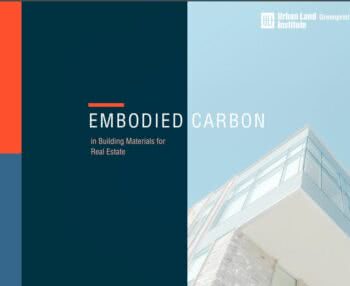
How to Get Embodied Carbon Out of Your Construction Process and Save Money
| WASHINGTON – The Urban Land Institute’s (ULI) Greenprint Center for Building Performance has released a new 26-page report, Embodied Carbon in Buildings Materials for Real Estate, explaining how reducing embodied carbon in the construction process can save developers money and help mitigate the impacts of climate change. Greenprint is a worldwide alliance of leading real estate owners, investors, and strategic partners committed to improving the environmental performance of the global real estate industry. Through measurement, benchmarking, knowledge sharing, and implementation of best practices, Greenprint and its members are striving to reduce greenhouse gas emissions by 50 percent by 2030.
Embodied carbon in buildings, which refers to the emissions associated with the manufacturing, transportation, construction of building materials, as well as building disposal, currently accounts for 11 percent of all global greenhouse gas emissions. In some cases, due in large part to carbon-intensive material manufacturing processes and the large quantities of fossil fuels used before materials ever reach the construction site, embodied carbon can account for as much as half of a building’s total carbon footprint over its lifetime. To achieve ambitious climate goals, such as those set in the Paris Climate Agreement, addressing embodied carbon will need to be part of real estate’s climate mitigation strategy. “To date, the real estate market has made fantastic progress on operational improvements to reduce carbon emissions. Now, we’re looking at the other half of the built environment’s footprint: the embodied carbon in building materials,” said Billy Grayson, executive director of the Center for Sustainability and Economic Performance, which houses the Greenprint Center. “With the release of Embodied Carbon in Building Materials, ULI is pleased to drive the discussion and promote action among the real estate industry by sharing the evolving business case for addressing embodied carbon in buildings, and sharing simple steps developers can take to reduce their environmental footprint in a cost effective manner.” The report details multiple steps that constructors and developers can take to reduce their embodied carbon:
The report adds to ULI’s ongoing efforts to promote sustainable development practices, and to highlight the Institute’s role in helping to mitigate the effects of climate change that are related to the built environment.
|
About ULI’s Center for Sustainability and Economic Performance
The ULI Center for Sustainability and Economic Performance is dedicated to creating healthy, resilient, and high-performance communities around the world. Through the work of its Greenprint, Building Healthy Places, and Urban Resilience programs, the Center provides leadership and support to real estate and land use professionals to invest in energy efficient, healthy, resilient, and sustainable buildings and communities.
About the ULI Greenprint Center for Building Performance
ULI Greenprint’s mission is to lead the global real estate industry towards improved environmental performance, focusing on energy efficiency and reduced carbon emissions to drive value. Greenprint is a member-driven organization that achieves its goals through measurement, action and education.
Greenprint is comprised of the following members: Allianz; AXA-IM – Real Assets; Boston Properties; CenterPoint Properties; BlackRock; CalPERS; Clarion Partners; CommonWealth Partners; DWS; FCP; FPA Multifamily; GID; GLL Real Estate Partners; Granite Properties; Heitman; The Howard Hughes Corporation; Hudson Pacific Properties; Jamestown Properties; JBG SMITH; Jones Lang LaSalle; Kilroy Realty; LaSalle Investment Management; LendLease Americas; Morgan Creek Ventures LLC; MultiGreen Properties; NEO; Parkway Properties; PGIM Real Estate; Prologis; Rudin Management Company, Inc.; Savanna; SL Green; Sonae Sierra; Tishman Speyer; UDR Inc; and Zurich Alternative Asset Management.
For additional information, visit uli.org/greenprint.